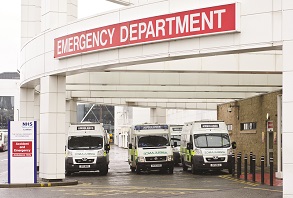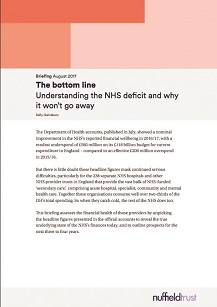Technical / Updated guidance confirms A&E link for STF performance fund
 Providers’ oversight body announced its plans earlier in the year to drop the link between STF payments and cancer and elective access targets. But guidance, updated in September, has now formally confirmed how the fund will operate for the coming two years.
Providers’ oversight body announced its plans earlier in the year to drop the link between STF payments and cancer and elective access targets. But guidance, updated in September, has now formally confirmed how the fund will operate for the coming two years.
The sustainability and transformation fund and financial control totals for 2017/18 and 2018/19: guidance also confirms that providers will only be able to access the performance element of their fund allocations – 30% of the total – if they first meet their agreed control totals.
Performance against the year-to-date control totals in each quarter of both the years will act as a ‘binary on/off switch’ to access STF funds. A provider that misses its Q1 control total will not receive any STF funds for the quarter. If it subsequently achieves its Q2 control total, it will become entitled to previously missed quarters of STF, including performance funds if all the relevant criteria have been met.
To access the performance element, providers will need to achieve nationally set A&E trajectories through 2017/18, while making progress on A&E primary care streaming milestones. This will include achieving 95% of all patients seen within four hours by March 2018 and then sustaining this in 2018/19.
Control totals will be measured excluding receipt of the STF. This prevents a trust being penalised twice, so that a performance failure leading to missed STF funding cannot contribute to missing a control total – causing further funds to be withheld.
The guidance clarifies the technical accounting basis for control totals and this will be consistent across NHS trusts and foundation trusts. When calculating the performance against control total this year, the reported surplus/ deficit for the year will be adjusted to remove the effect of impairments charged to expenditure except those that arise from loss or damage, abandonment of projects or over-specification. Like last year, the I&E impact of capital donations and gains/losses on transfers by absorption will be removed from the calculated position.
The baseline used for a trust’s 2017/18 and 2018/19 control totals was its control total for 2016/17. This means that providers that did better than their control total in 2016/17 on the basis of recurring savings face a less demanding efficiency requirement this year. The guidance sets out the adjustments made to these baselines to calculate the new control totals.
The STF will amount to £1.8bn in both 2017/18 and 2018/19. There is a general element, including £1.5bn for providers of emergency care, allocated in proportion to the cost of the emergency services they provide, and a further £100m for non-acute services. The non-acute general element – for ambulance, mental health and community trusts – is allocated based on operating revenue. The remaining £200m makes up a targeted element of the fund.
The STF has been put together from resources that were allocated to the NHS as part of a recurrent real-terms uplift.
However, the guidance stresses that STF funding is non-recurrent for trusts and they should not count on it beyond 2018/19 (see box).
For the time being the fund remains focused on sustainability rather than transformation. As such it is intended to deliver a ‘pound-for-pound improvement’ in each trust’s bottom line. Commissioners cannot ask for the fund to be spent on delivering increased volumes of activity.
Underlying deficits
A report from the Nuffield Trust in August, claimed that while providers ended 2016/17 with a reported deficit of £791m, their real underlying deficit was £3.7bn.
In coming to this underlying figure, it added back non-recurrent efficiency savings and the sustainability and transformation fund on the grounds that the fund is also non-recurrent as far as providers are concerned.
The thinktank said even trusts earning STF funds and achieving a surplus last year can’t spend the funds this year as this would mean overspending compared to income received in 2017/18. This would mean missed control totals this year and prevent access to a further share of STF.
The analysis doesn’t however acknowledge that these surpluses could in theory be used on much needed building programmes – with sustainability and transformation plans needing significant levels of capital. However, overall capital spending is already constrained by the Department of Health’s restricted capital expenditure limit. NHS Improvement’s STF paper (see main story) also stresses that trusts ‘need to be prepared for continuing restrictions on both external finance access and deployment of existing cash reserves’.
Related content
The Institute’s annual costing conference provides the NHS with the latest developments and guidance in NHS costing.
The value masterclass shares examples of organisations and systems that have pursued a value-driven approach and the results they have achieved.